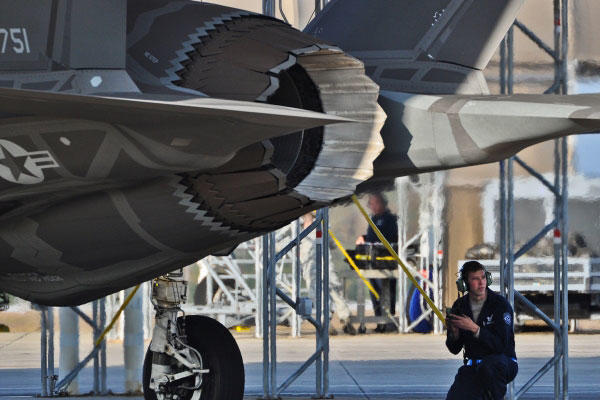FARNBOROUGH, England – Pentagon officials on Monday shed new light on what caused a fire that led to a recent grounding of the F-35 fighter jet, but didn't say when – or whether – the aircraft will make its international debut this week at one of the world's biggest airshows.
A preliminary investigation into a fire that crippled an F-35A during takeoff June 23 at Eglin Air Force Base in Florida was due to excessive rubbing of fan blades in a certain section of the Pratt & Whitney-made F135 engine, according to Air Force Lt. Gen. Christopher Bogdan, who manages Joint Strike Fighter program.
The rubbing was far more severe than normal and led to higher temperatures, cracking and fatigue, Bogdan said. "That's what caused that engine to come apart," he said during a briefing with reporters at the first day of the week-long Farnborough International Air Show outside London.
He didn't say whether the plane, which is made by Lockheed Martin Corp. and cost $112 million apiece, could be repaired or would have to be scrapped.
The incident is the second in less than a year to affect a part of the engine known as the integrally bladed rotor, or IBR. The component contains three sets of fans to help compress air into the engine. A first-stage fan made of hollow titanium blew apart during ground testing in December and is undergoing redesign, while a third-stage fan made of solid titanium disintegrated during the June takeoff.
Officials said the two cases aren't related.
A review of almost 100 engines in the fleet didn't find evidence of the same problem affecting the third-stage fan, though several showed signs of mild rubbing, Bogdan said. The extent of the problem appears to be isolated to that particular aircraft, an Air Force "A" model known as AF27 designed to take off and land on conventional runways, Pentagon and industry officials said.
"There is a growing body of evidence that this is not a systemic, major design problem," said Frank Kendall, the Defense Department's top weapons buyer.
In addition, the Pentagon has no plans to restart development of an alternative engine, he added. In 2011, then-Defense Secretary Bob Gates led a push to kill funding for a back-up propulsion system developed by General Electric Co. In the wake of the engine fire, some have criticized the cost-cutting move.
"We're still confident in the design," Kendall said.
Kendall and Bogdan were flanked by other senior Pentagon officials and executives from Lockheed Martin, Pratt & Whitney, and other F-35 contractors.
"This is not related to any incident in the past," Pratt & Whitney President Paul Adams said of the problem.
Highlighting just how unpredictable development programs such as the F-35 can be, the company in trade publications distributed at the show ran full-page advertisements that described the F135 engine as "straight up dependable."
Lockheed Chief Executive Officer Marillyn Hewson said the company and its subcontractors are working on reducing the cost of the fifth-generation stealth fighter program. She touted a recently announced pledge to invest $170 million through 2016 for various affordability initiatives.
The Joint Strike Fighter is the Pentagon's most expensive acquisition program, estimated to cost nearly $400 billion for 2,443 aircraft. Keeping the planes flying over the next half-century may cost another $1 trillion in sustainment.
At the airshow, attendees gathered in lines to sit in the cockpit of a full-scale F-35 model on display on the flight line. Farnborough was supposed to be the third and final event in the United Kingdom at which the Pentagon's newest fighter jet was to make an appearance as part of its international debut.
The U.S. has four F-35B jump-jet variants, including three Marine Corps and one Royal Air Force aircraft, standing by at Naval Air Station Patuxent River in Maryland.
The F-35Bs were originally scheduled to conduct a fly-over on July 4 at Rosyth Dockyard, Scotland, as part of a naming ceremony for the new British aircraft carrier, the HMS Queen Elizabeth. They were supposed to be on display last week at the Royal International Air Tattoo and then fly this week at Farnborough.
The appearances were designed in part to send a message to international partners and potential buyers that the single-engine fighter has rounded the corner in terms of development. The program, which began development in the 1990s, has been plagued by design challenges, cost overruns and schedule delays.
Eight countries have committed to help develop the F-35, including the U.K., Italy, the Netherlands, Turkey, Canada, Australia, Denmark and Norway. Also, Israel, Japan and South Korea plan to buy production models of the aircraft.
Officials downplayed the impact of the plane's potential to be a no-show on would-be customers.
Bogdan, the program manager, said everyone is "disappointed" the planes aren't at Farnborough yet. While he seemed to hold out hope that they may arrive at the show by the end of the week, he also dismissed a post on Pax River's official Facebook page stating the planes were slated to leave the base on Tuesday for the transatlantic trip.
-- Brendan McGarry can be reached at brendan.mcgarry@monster.com



























